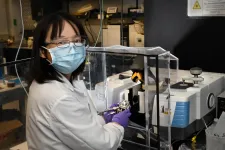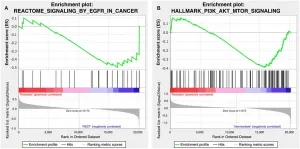(Press-News.org) BOSTON - When patients arrive in emergency departments and hospitals with symptoms consistent with COVID-19, it's critical to isolate them to avoid the potential spread of infection, but keeping patients isolated longer than needed could delay patient care, take up hospital beds needed for other patients, and unnecessarily use up personal protective equipment. A team led by investigators at Massachusetts General Hospital (MGH) has now created a tool to guide frontline clinicians through diagnostic evaluations of such patients so that they'll know when it's safe to discontinue precautions. The tool was developed and validated in a study published in Clinical Infectious Diseases.
In the spring of 2020, due to the risk of false-negative test results, the Infectious Diseases Society of America recommended repeating a COVID-19 test in patients with moderate to high probability of COVID-19; however, there was little guidance about what factors led to a patient being low or high probability. "So a team of infectious disease specialists at MGH worked around the clock to review admitted patients one by one to provide guidance about who needed additional testing and whose probability of COVID-19 was low enough that isolation could be discontinued," says Caitlin Dugdale, MD, an infectious disease physician at MGH and one of the study's co-first authors.
The effort led to the creation of a tool called the COvid Risk cALculator (CORAL), a clinical-decision support system embedded within the electronic health record. It was developed based on a rigorous review of the medical literature and the experience of a team of infectious disease specialists.
When using CORAL for a patient with symptoms of COVID-19, a clinician answers several questions about the patient's risk factors, symptoms and imaging findings, and is guided through a standardized COVID-19 diagnostic workup of the patient based on up-to-date guidelines.
"We designed the CORAL tool to be easy for frontline clinicians to use and also to help ensure patient and health care personnel safety," says Erica Shenoy, MD, PhD, an infectious diseases physician and infection control expert and co-senior author of the study, who has served as the infection control clinical lead for Mass General Brigham's electronic health record for several years. "By standardizing the approach to the assessment of patients with symptoms of COVID-19, we minimize the chance that a patient with a false-negative test escapes detection, which could put other patients and health care personnel at risk of exposure."
In the study, CORAL dramatically reduced the time required by clinicians to assess patients, and it decreased the average time that hospitalized patients were kept in isolation during evaluation for COVID-19. Among 2,000 patients assessed with CORAL, none had a positive COVID-19 test within seven days after discontinuation of precautions via CORAL.
Since CORAL's launch in May 2020, it has been used more than 30,000 times and is now in place at eight acute care hospitals in the Boston area, as well as four rehabilitation hospitals. An outpatient version of CORAL was launched in October 2020 and is in use in hundreds of Mass General Brigham affiliated practices.
Importantly, CORAL can be rapidly adapted as new guidelines or research related to COVID-19 diagnostics emerge.
INFORMATION:
Emily Hyle, MD, one of the leaders of the Infectious Diseases review team at MGH, is co-senior author of the study. David Rubins, MD, an internist and informaticist, is co-first author of the study, and he co-leads the clinical decision support team for Mass General Brigham.
This work was supported by departmental funds and the National Institute of Allergy and Infectious Diseases, the Eunice Kennedy Shriver National Institute of Child Health and Human Development, the Centers for Disease Control and Prevention, Harvard Catalyst, the Cystic Fibrosis Foundation, the Sullivan Family Foundation and the Roger I. and Ruth B. MacFarlane Foundation.
About the Massachusetts General Hospital
Massachusetts General Hospital, founded in 1811, is the original and largest teaching hospital of Harvard Medical School. The Mass General Research Institute conducts the largest hospital-based research program in the nation, with annual research operations of more than $1 billion and comprises more than 9,500 researchers working across more than 30 institutes, centers and departments. In August 2020, Mass General was named #6 in the U.S. News & World Report list of "America's Best Hospitals."
UPTON, NY--Scientists at the U.S. Department of Energy's Brookhaven National Laboratory, Stony Brook University (SBU), and other collaborating institutions have uncovered dynamic, atomic-level details of how an important platinum-based catalyst works in the water gas shift reaction. This reaction transforms carbon monoxide (CO) and water (H2O) into carbon dioxide (CO2) and hydrogen gas (H2)--an important step in producing and purifying hydrogen for multiple applications, including use as a clean fuel in fuel-cell vehicles, and in the production of hydrocarbons.
But because ...
A team of Russian scientists from NUST MISIS, Tomsk Polytechnic University (TPU) and Boreskov Institute of Catalysis has suggested a new approach to modifying the combustion behavior of coal. The addition of copper salts reduces the content of unburnt carbon in ash residue by 3.1 times and CO content in the gaseous combustion products by 40%, the scientists found. The research was published in Fuel Processing Technology.
According to the International Energy Agency (IEA), coal is the predominant energy resource used as the primary fuel for power generation. According to reports, coal supplied over one-third of global electricity generation in ...
Oncotarget published "Combination of copanlisib with cetuximab improves tumor response in cetuximab-resistant patient-derived xenografts of head and neck cancer" which reported that HNSCC is frequently associated with either amplification or mutational changes in the PI3K pathway, making PI3K an attractive target, particularly in cetuximab-resistant tumors.
Here, the authors explored the antitumor activity of the selective, pan-class I PI3K inhibitor copanlisib with predominant activity towards PI3Kα and δ in monotherapy and in combination with cetuximab using a mouse clinical trial set-up with 33 patient-derived xenograft models with known HPV and PI3K mutational status and available data ...
Scientists and public health experts have long known that certain individuals, termed "super-spreaders," can transmit COVID-19 with incredible efficiency and devastating consequences.
Now, researchers at Tulane University, Harvard University, MIT and Massachusetts General Hospital have learned that obesity, age and COVID-19 infection correlate with a propensity to breathe out more respiratory droplets -- key spreaders of SARS-CoV-2, the virus that causes COVID-19. Their findings were published in Proceedings of the National Academy of Sciences.
Using data from an observational study of 194 healthy people and an experimental study of nonhuman primates with COVID-19, researchers found that exhaled aerosol particles vary greatly ...
(New York, NY) February 10, 2021 - A research team led by the Icahn School of Medicine at Mount Sinai (Icahn Mount Sinai) has built the first cellular model to depict the evolution of acute myeloid leukemia (AML), from its early to late stages. By using gene editing technologies to alter genes that make cells malignant, the team was able to identify potential therapeutic targets for early disease stages. The study was reported in the journal Cell Stem Cell in February.
The therapeutic targets could be applicable not just to AML but also to the blood cancer myelodysplastic syndrome and clonal hematopoiesis, which is often a preleukemic condition.
"We essentially built from scratch a model of leukemia that characterizes the ...
Global emissions of a potent substance notorious for depleting the Earth's ozone layer - the protective barrier which absorbs the Sun's harmful UV rays - have fallen rapidly and are now back on the decline, according to new research.
Two international studies published today in Nature, show emissions of CFC-11, one of the many chlorofluorocarbon (CFC) chemicals once widely used in refrigerators and insulating foams, are back on the decline less than two years after the exposure of their shock resurgence in the wake of suspected rogue production.
Dr Luke Western, from the University of Bristol, a co-lead author of one ...
When we tear a muscle " stem cells within it repair the problem. We can see this occurring not only in severe muscle wasting diseases such as muscular dystrophy and in war veterans who survive catastrophic limb injuries, but also in our day to day lives when we pull a muscle.
Also when we age and become frail we lose much of our muscle and our stem cells don't seem to be able to work as well as we age.
These muscle stem cells are invisible engines that drive the tissue's growth and repair after such injuries. But growing these cells in the lab and then using them to therapeutically replace damaged muscle has been frustratingly difficult.
Researchers at the Australian Regenerative Medicine Institute at Monash University in Melbourne, ...
Researchers at the Centre for Genomic Regulation (CRG) reveal that newly formed embryos clear dying cells to maximise their chances of survival. It is the earliest display of an innate immune response found in vertebrate animals to date.
The findings, which are published today in the journal Nature, may aid future efforts to understand why some embryos fail to form in the earliest stages of development, and lead to new clinical efforts in treating infertility or early miscarriages.
An embryo is fragile in the first hours after its formation. Rapid cell division and environmental stress make them prone to cellular errors, which in turn cause the sporadic death of embryonic stem cells. This is ...
For nearly a century, scientists have worked to unravel the mystery of dark matter--an elusive substance that spreads through the universe and likely makes up much of its mass, but has so far proven impossible to detect in experiments. Now, a team of researchers have used an innovative technique called "quantum squeezing" to dramatically speed up the search for one candidate for dark matter in the lab.
The findings, published today in the journal Nature, center on an incredibly lightweight and as-of-yet undiscovered particle called the axion. According to theory, axions are likely billions to trillions of times smaller than electrons and may have been created during the Big Bang in humungous numbers--enough ...
What The Study Did: This observational study describes differences in the number of COVID-19 deaths by nursing home racial composition and examines the factors associated with these differences.
Authors: Rebecca J. Gorges, Ph.D., of the University of Chicago, is the corresponding author.
To access the embargoed study: Visit our For The Media website at this link https://media.jamanetwork.com/
(doi:10.1001/jamanetworkopen.2020.37431)
Editor's Note: The article includes funding/support disclosures. Please see the article for additional information, including other authors, author contributions and affiliations, conflict of interest ...




